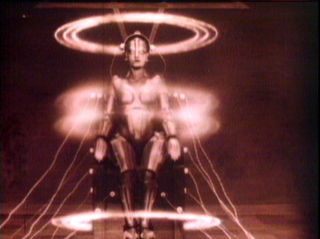 Metropolis
Metropolis
Course objectives: By the end of the semester, students will have;
read a selection of early 20th-century European novels by authors from different
European countries
analyzed common themes and allusions in these novels, and related them to
historical, cultural and social currents of the time
done close analyses of texts, discussing theme, imagery, poetic technique
written several papers about the literature they've studied
become familiar with a variety of critical approaches to the literature of
20th-century Europe from the turn of the century to the 1930s
2. There will be 3 one-page response papers (15%). Response papers are due
BEFORE the class meeting in which they will be discussed.
3. All work is due when assigned. One paper may be handed in late (your choice),
but no more than one week late. No other late work will be accepted.
5. Please come to class having completed that day's reading and prepared to
join the conversation. Much depends on your participation. (20%)
8. Plagiarism will result in an automatic F for the course.
Proust, Marcel. Swann's Way
Gide, Andre. The Immoralist. Trans. Richard Howard. Vintage.
Kafka, Metamorphosis. Trans. Corngold. Norton.
Mann, Thomas. Death in Venice. Norton.
Bulgakov. Master and Margarita. Trans. Pevear and Volokhonsky. Penguin.
Svevo, Italo. Zeno's Conscience. Trans. Weaver. Vintage.
15% -- response papers
10% - first 3-page paper
15% - second 3-page papger
20%---participation
30%---final research paper
5%- discussion leader
5% - final presentation
Group 1: Haneen, Matthew, Eduard, Kevin, Nicole, Eric, Tracey
Group 2:
 Renoir,
Madame Charpentier and her daughters
Renoir,
Madame Charpentier and her daughters
(1878) Met. Museum
drawing-room of the publisher Charpentier as painted by Renoir? Time Regained
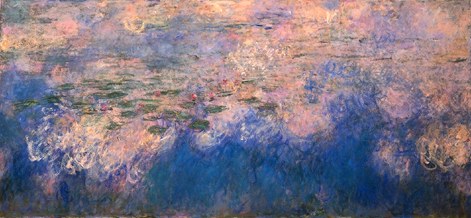 Monet,
Waterlilies (1906)
Monet,
Waterlilies (1906)
Poster Art (late 19th century):
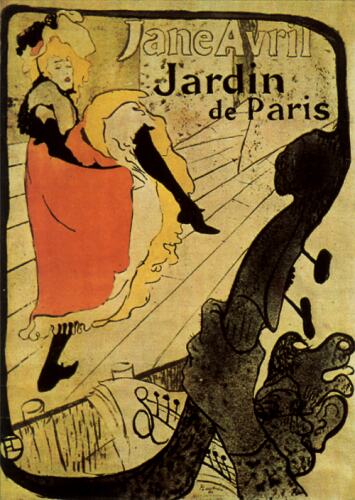 Toulouse-Lautrec
Toulouse-Lautrec
 Braque,
Woman with a Guitar
Braque,
Woman with a Guitar Picasso,
Demoiselle d'Avignon
Picasso,
Demoiselle d'Avignon
Read Swann's Way, p. 1-64
Pay close attention to the description of the rooms, p. 6-9
Response paper: 1 page: any aspect of these pages that you find interesting,
troubling, provocative; or respond to the description of the madeleine, p.
61-64.
Read Weber, France Fin de
Siecle, How They Lived
Grandmother's gifts:
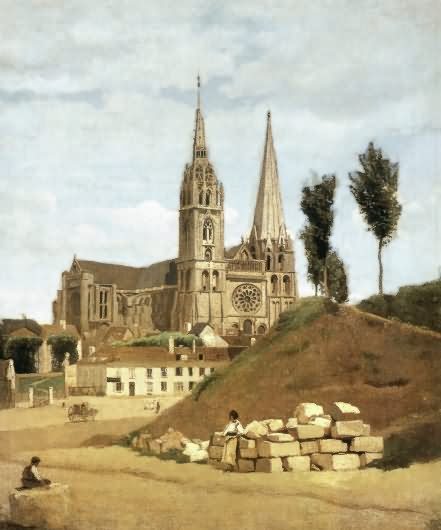 Corot,
Chartres Cathedral
Corot,
Chartres Cathedral
"Instead of photographs of Chartres Cathedral, the Fountains of Saint-Cloud,
of Vesuvius, she would inquire of Swann whether some great painter had not
depicted them, and preferred to give me photographs of "Chartres Cathedral"
after Corot, of the "Fountains of Saint-Cloud" after Hubert Robert,
and of "Vesuvius" after Turner." — Swann's Way
Week 3: Wednesday, Feb. 11:
Read Swann's Way, p. 65-168.
Response paper #2: Of course, any aspect of the reading that interests you,
or:
a close analysis of the hawthorns, p. 155-56; 158
a close analysis of the church steeple, p. 88-89
Giotto allusion, p. 110-113.
Landy, The Texture of Proust's Novel
Discussion leader: Kurt

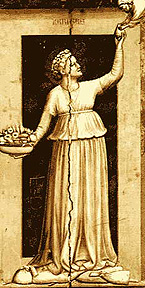
"There must have been a good deal of reality in those Virtues and Vices
of Padua, since they seemed to me as alive as the pregnant servant, and since
she herself did not appear to me much less allegorical." — Swann's
Way
 hawthorns
hawthorns
Week 4: Wednesday, Feb. 25
Read Swann's Way, p. 169-471
Response paper possible topics: sadism (224); the evolution of Swann's love
for Odette; close analysis of the cattleyas scene (328-330); waterlilies (239);
hawthorns, again (195-97); musical phrase (294-96); Botticelli (314-18); or
any topic of your choice.
Read Bloom
on jealousy.
Discussion leader:
 Botticelli,
Madonna of the pomegranates
Botticelli,
Madonna of the pomegranates
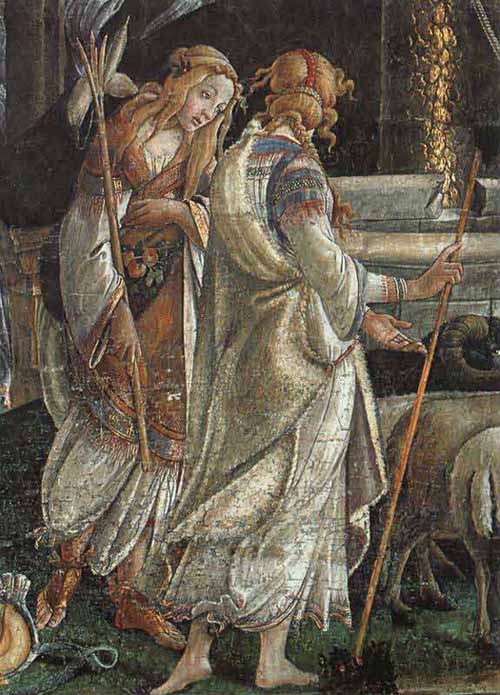 Botticelli,
Zipporah
Botticelli,
Zipporah
Week 5: Wednesday, March 4:
Finish Swann's Way.
Response papers: Analyse Swann's dream (p. 538); Odette's past (516-26); the
end of love (537-38); names (551);the zoological analogy in the Bois de Boulogne
(592-93); any topic of your choosing.
Read Kristeva
on metonymy
Discussion leader: Ashley
Paper 1 Group 1: One of the following topics; 3 pages:
1. Love as illness
2. Love and art---Swann's love for Odette and its artistic substitutes (Botticelli;
Vinteuil's litte phrase)
3. Floral imagery---hawthornes and cattleyas
 Mantegna"The
Martyrdom of St. James" (1453) Eremitani Church, Padua
Mantegna"The
Martyrdom of St. James" (1453) Eremitani Church, Padua
"A few feet away, a strapping great fellow in livery stood musing, motionless,
statuesque, useless, like that purely decorative warrior whom one sees in
the most tumultuous of Mantegna's paintings, lost in thought, leaning upon
his shield, while other people around him are rushing about slaughtering each
other." — Swann's Way
Week 6: Wednesday, Mar 11: Read Gide's Immoralist
Response papers: anything that interests you; the quote that opens the
story; the frame device Gide uses; the consummation of the marriage; the sunbathing
on the rock; the shaving of the beard; the stolen scissors; the contrast between
the landscapes in north Africa and in Normandy; the balance between body and
mind; Biblical quotes; the relationship between Michel's theory of life and
Nietzsche's in Thus Spake Zarathustra; the difference between immorality and
amorality; the role of the exotic.
Discussion leader: Matthew on Nietzsche; Nicole on Gide
Read the summary and excerpts
from Nietzsche's Thus Spake Zarathustra:
But the awakened one, the knowing one, saith: "Body am I entirely, and
nothing more; and soul is only the name of something in the body."
Behind thy thoughts and feelings, my brother, there is a mighty lord, an unknown
sage- it is called Self; it dwelleth in thy body, it is thy body.
There is more sagacity in thy body than in thy best wisdom
Man is something that hath to be surpassed: and therefore shalt thou love
thy virtues,- for thou wilt succumb by them.-
I should only believe in a God that would know how to dance.
And when I saw my devil, I found him serious, thorough, profound, solemn:
he was the spirit of gravity- through him all things fall.
Not by wrath, but by laughter, do we slay. Come, let us slay the spirit of
gravity!
I learned to walk; since then have I let myself run. I learned to fly; since
then I do not need pushing in order to move from a spot.
Now am I light, now do I fly; now do I see myself under myself. Now there
danceth a God in me.-
Flee, my friend, into thy solitude: I see thee stung all over by the poisonous
flies. Flee thither, where a rough, strong breeze bloweth!
Flee into thy solitude! Thou hast lived too closely to the small and the pitiable.
Flee from their invisible vengeance! Towards thee they have nothing but vengeance.
....
O my friend, man is something that hath to be surpassed.
Far too long hath there been a slave and a tyrant concealed in woman. On that
account woman is not yet capable of friendship: she knoweth only love.
In woman's love there is injustice and blindness to all she doth not love.
And even in woman's conscious love, there is still always surprise and lightning
and night, along with the light.
As yet woman is not capable of friendship: women are still cats and birds.
Or at the best, cows.
As yet woman is not capable of friendship
And be on thy guard against the good and just! They would fain crucify those
who devise their own virtue- they hate the lonesome ones.
....
Elevated is then your body, and
raised up; with its delight, enraptureth it the spirit; so that it becometh
creator, and valuer, and lover, and everything's benefactor.
When your heart overfloweth broad and full like the river, a blessing and
a danger to the lowlanders: there is the origin of your virtue.
When ye are exalted above praise and blame, and your will would command all
things, as a loving one's will: there is the origin of your virtue.
When ye despise pleasant things, and the effeminate couch, and cannot couch
far enough from the effeminate: there is the origin of your virtue.
When ye are willers of one will, and when that change of every need is needful
to you: there is the origin of your virtue.
Verily, a new good and evil is it! Verily, a new deep murmuring, and the voice
of a new fountain!
Power is it, this new virtue; a ruling thought is it, and around it a subtle
soul: a golden sun, with the serpent of knowledge around it.
Awake and hearken, ye lonesome ones! From the future come winds with stealthy
pinions, and to fine ears good tidings are proclaimed.
Ye lonesome ones of today, ye seceding ones, ye shall one day be a people:
out of you who have chosen yourselves, shall a chosen people arise:- and out
of it the Superman.
Verily, a place of healing shall the earth become! And already is a new odour
diffused around it, a salvation-bringing odour- and a new hope!
Once did people say God, when they looked out upon distant seas; now, however,
have I taught you to say, Superman.
God is a conjecture: but I do not wish your conjecturing to reach beyond your
creating will.
Could ye create a God?- Then, I pray you, be silent about all gods! But ye
could well create the Superman.
Not perhaps ye yourselves, my brethren! But into fathers and forefathers of
the Superman could ye transform yourselves: and let that be your best creating!-
God is a conjecture: but I should like your conjecturing restricted to the
conceivable.
Could ye conceive a God?- But let this mean Will to Truth unto you, that everything
be transformed into the humanly conceivable, the humanly visible, the humanly
sensible! Your own discernment shall ye follow out to the end!
And what ye have called the world shall but be created by you: your reason,
your likeness, your will, your love, shall it itself become! And verily, for
your bliss, ye discerning ones!
And how would ye endure life without that hope, ye discerning ones? Neither
in the inconceivable could ye have been born, nor in the irrational.
But that I may reveal my heart entirely unto you, my friends: if there were
gods, how could I endure it to be no God! Therefore there are no gods.
Yea, I have drawn the conclusion; now, however, doth it draw me.-
Away from God and gods did this
will allure me; what would there be to create if there were- gods!
But to man doth it ever impel me anew, my fervent creative will; thus impelleth
it the hammer to the stone.
Ah, ye men, within the stone slumbereth an image for me, the image of my visions!
Ah, that it should slumber in the hardest, ugliest stone!
Now rageth my hammer ruthlessly against its prison. From the stone fly the
fragments: what's that to me?
I will complete it: for a shadow came unto me- the stillest and lightest of
all things once came unto me!
The beauty of the superman came unto me as a shadow. Ah, my brethren! Of what
account now are- the gods to me!-
Thus spake Zarathustra.
Since humanity came into being,
man hath enjoyed himself too little: that alone, my brethren, is our original
sin!
And when we learn better to enjoy ourselves, then do we unlearn best to give
pain unto others, and to contrive pain
It moveth my heart for those priests. They also go against my taste; but that
is the smallest matter unto me, since I am among men.
But I suffer and have suffered with them: prisoners are they unto me, and
stigmatised ones. He whom they call Saviour put them in fetters:-
In fetters of false values and fatuous words! Oh, that some one would save
them from their Saviour!
Oh, just look at those tabernacles which those priests have built themselves!
Churches, they call their sweet-smelling caves!
Oh, that falsified light, that mustified air! Where the soul- may not fly
aloft to its height
Nietzsche dismisses this answer
to nihilism. As effective as it is he finds fault with it in that it serves
to make one feel ashamed of himself and the world. In so doing this belief
extinguishes an individual's hope of fully realizing his own powers and strengths
as such things are viewed in a negative light as being worldly thus evil.
Nietzsche holds that such suppression tends to undermine an individual making
him sickly and weak physically and psychologically (144-145); such a thing
imposed upon society would naturally lead to a sick and weak population. Not
seeing any overall gain in a system of beliefs which teaches suppression,
he purposes to give us a new one which is not only said to be as effective
but also frees us of Christianity's binds. With his doctrine of the superman
Nietzsche seeks to give us values that at the same time, create a medium where
power is realized and strength flourishes, and define a purpose for life.
The superman is someone who in discovering himself (306) also discovers that
it is in his best interests to reject any outside notions about values, trusting
rather what he finds within himself. He creates his own good and evil, based
on that which helps him to succeed or fail. In this way good is something
which helps one to realize his potential and evil is whatever hampers or stands
in the way of this effort. Since to Nietzsche everything in the world, including
good and evil, is transitory (228) everything is being continually reinvented.
The superman embraces this idea of change which to him appears evident, he
understands the fact that since there is nothing in the world which is permanent
whatever exists must eventually be overcome by something else which comes
along. Seeing himself and his values in the same light he knows that these
aspects must also be overcome by something stronger if not by him than by
someone or something else. So in order to keep up with the times he continuously
reinvents himself over and over always building something stronger, more powerful,
on top of what went before. The superman therefore is the ideal of someone
who has mastered the practice of overcoming himself.
The source of his strength lies in the cherishing of the same natural desires
restricted in Christianity. Sex for him is, "a great invigoration of
the heart", the lust to rule a "gift giving virtue" (in that
it allows new ideas and life to ascend to those "pure and lonely self-sufficient
heights" which "should not remain lonely and self sufficient eternally"),
and selfishness is "blessed, wholesome [and] healthy" (301-302).
He sees these insatiable desires as the best of all possible good since they
act as the driving force behind his insatiable need to overcome, they spur
him on always seeking their ever demanding satisfaction.
It is from the example of the superman that we are intended to see how much
is actually attainable in the world. The values he creates he continually
tests himself always refining them to be better and better still. In this
way they rise above the values of the masses (the weaker, the unwise) until
they arrive at the top and being superior to any other they serve as the guidelines
for the rest of society. They remain on top until another superior system
of values comes along and usurps it. In this way a society is created which,
by allowing the stronger to prevail, promotes strength. Nietzsche deems this
a healthy society as it always strives to heighten its potential and is founded
upon the attributes of the healthiest individual who exists. It is a macroscopic
version of the same sort of overcoming which occurs in the superman and is
labeled healthy because weakness is discouraged in favor of a medium in which
strength and superiority are pushed to the level of utmost importance.
In this system the question "why live?" asked by nihilists is answered
in man's striving to overcome himself. The superman sees mankind as a bridge
which has no end (310) which always stretches still further and further. Thus
mankind is aware of no ultimate limits. Each life is valuable as it can serve
mankind by helping to push its potential ever higher, making it that much
stronger, elevating it another step out of the comparative wretchedness which
existed before this process was begun.
Suffering is also addressed here. We are told that not only can suffering
be suppressed but the alleviation of it is also possible. Though suffering
is at times necessary the superman redeems himself from it in his constant
creating. This creating which allows him to overcome himself and through trial
thus leads to improvement he calls his "will's joy" (199). So if
in order to overcome himself he must create and in creating he feels joy if
he is constantly overcoming then with all the resulting joy he experiences,
naturally, very little room is left for suffering.
We see that an understanding of Nietzsche's philosophy would not be complete
without an understanding of the idea of the superman, the central and most
crucial aspect about it. In eliminating the idea of God and the values attached
to it in his system he is forced to give us a parallel substitute, that is,
another god like figure from whom we may receive our new values in order to
fill the void which is created. We get an individual who derives his strength
from that which is tangible (namely, his own self) and dismisses that which
cannot be plainly observed in the everyday world. Christianity in placing
such a level of importance on the conjectures of the unseen (198) and dismissing
that which is tangible becomes directly opposed to the former. The two doctrines,
therefore, are each other's exact opposites and can never be reconciled as
the one's good is the other's evil and vice versa.
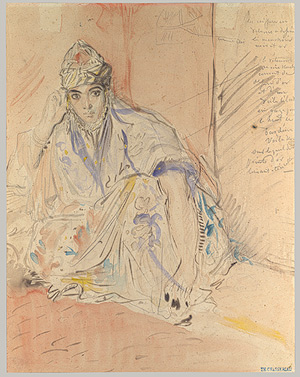
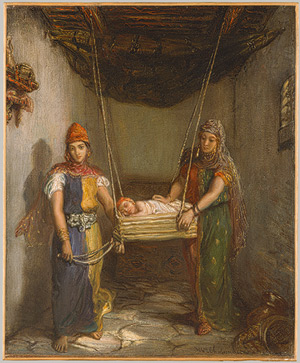
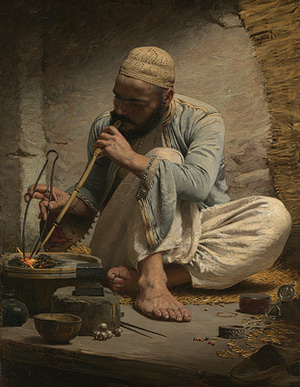 Arab
jeweler
Arab
jeweler
Algerian Jew
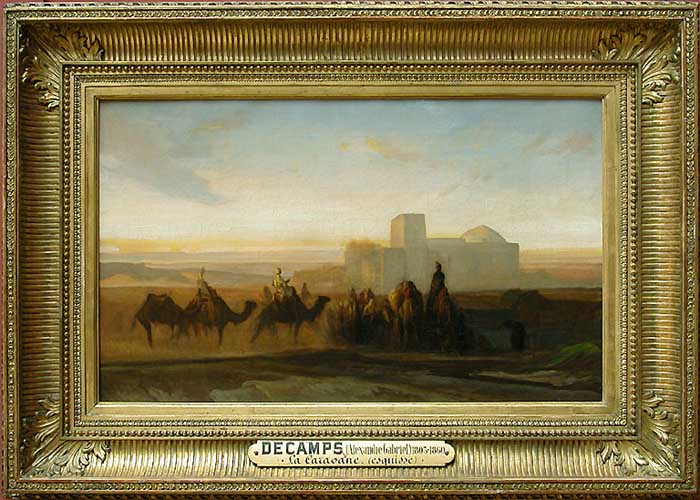 Caravan
Caravan
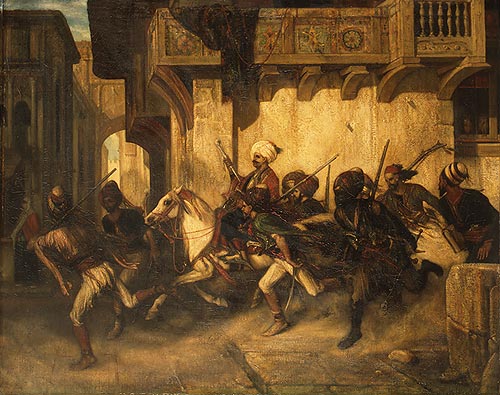 Smyrna
Smyrna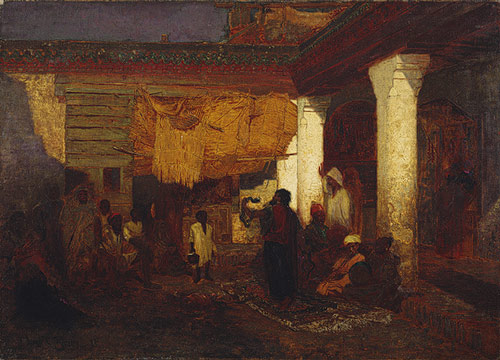 Tangiers
Tangiers
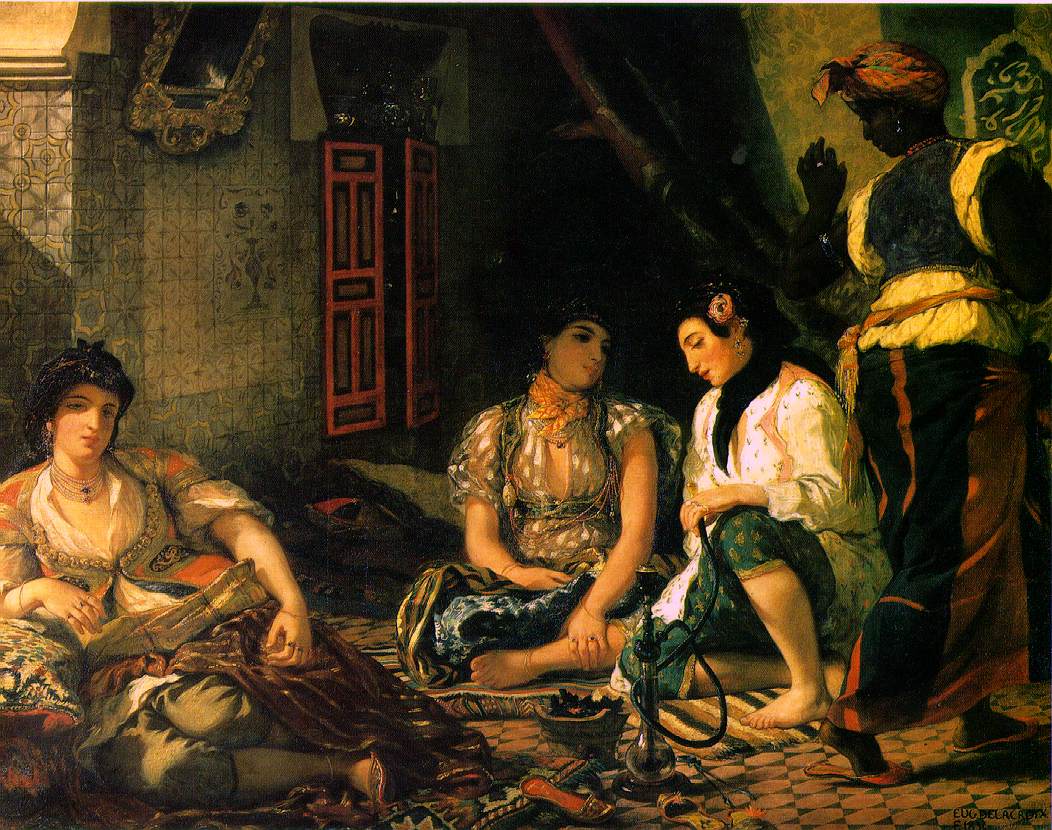
Week 7: Wednesday, March 18: Read Death in Venice, p. 3-63;
also read "Nietzsche and Mann," p. 130-149
Response paper: Either continue to write on Gide: the Biblical quote "When
thou was young..." (47); the balance of scenes, characters; any topic
that interests you; or write on Mann: colors; strangers; epithets used to
describe Aschenbach; Venice; or, again, anything that intrigues you.
For a comparison of Gide and Mann, read
http://www.andregide.org/studies/immgue.html
Discussion leader: Bella
Paper 1, Group 2: 3 pages; one of the topics below:
1. Contrasting images of nature in the Immoralist
2. Images of the illicit---how do these shape the narrative?
3. The exotic
Lo spinario, Roman, 1st century AD, Copy
of a Hellenistic Greek original of the 3rd century BC, British Museum
t
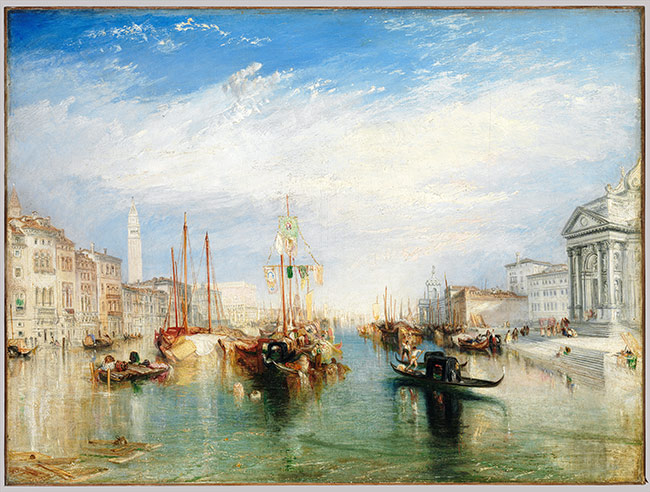 Turner, Venice,
ca. 1835, Metropolitan Museum of Art.
Turner, Venice,
ca. 1835, Metropolitan Museum of Art.
Lo Spinario, (Boy with Thorn), Capitiline Museum, Rome.
Response paper: the color red; the straw hat; comparisons with Gide; anything
you like
Discussion leader: Eric
Look at the following images of Dionysos:
http://www.metmuseum.org/toah/hd/grmu/ho_06.1021.178.htm
http://www.metmuseum.org/toah/hd/vase/ho_31.11.11.htm
http://www.metmuseum.org/toah/ho/05/eust/ho_55.11.5.htm
For a summary of the pertinent sections from Plato's Symposium (sections 201d-212s)
and Phaedrus (sections 244b-257b), click the links below:
http://caae.phil.cmu.edu/Cavalier/80250/Plato/index.html
Week 9: Wednesday, April 1: Kafka, Metamorphosis.:
Discussion leader: Haneen
Start planning the final paper. 8-10 pages, MLA format
Possible response papers: explain the quote: "I was about to take a wife
very far from my own country" (69); symbols: cigarettes, locomotives;
why Trieste?; the father; Zeno's paradoxes.... or anything that might interest
you.
Discussion leader: Katherine; Allen
Discussion leaders: Kevin; Rabia
Paper 2, Group 1: Possible topics: Or find a topic of your own
(check with me before you write)
Classical allusions in Death in Venice
Mann and Gide
Oppositions in Death in Venice (Apollo/Dionysos)
Narrative style in Death in Venice
Symbolism in Death in Venice (Venice; the color red; the exotic)
Discussion leader: Tracey and/or Edward
Paper 2, Group 2:
Freudian influences in Zeno's Conscience
illness/health
Schopenhauer and Svevo
Alienation
Time in Zeno's Conscience
http://cr.middlebury.edu/public/russian/Bulgakov/public_html//intro.html
Week 13: Wednesday, May 6: Finish Master and Margarita.
Discussion leader: Eduard and/or Tracey
Click here for Russian poster art:
http://ngart.com/posters
Discussion leader: Tracey
Presentations must include:
An annotated bibliography of 3 secondary sources, in MLA format
Three quotes or passages from the primary source that you will analyze in
your paper.
May 13: Bella, Kurt, Matt, Eric, Katherine, Ashley
May 20: Kevin, Nicole, Allen Haneen, Edward, Rabia
1. Look at paintings from the 1870s and 1880s (Renoir, Tissot, Degas) and compare the fashion (hair, dress, furniture) to the descriptions of Odette in Swann in Love. .
2. Go to the Greek
and Roman galleries and look at the classical male statues. Discuss these
statues as models for the descriptions of Tadzio in Death in Venice.